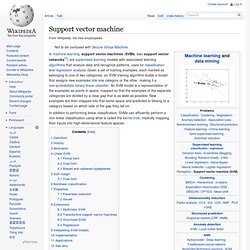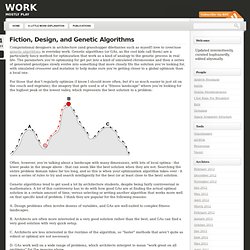

Home.
Neural network. An artificial neural network is an interconnected group of nodes, akin to the vast network of neurons in a brain.

Here, each circular node represents an artificial neuron and an arrow represents a connection from the output of one neuron to the input of another. For example, a neural network for handwriting recognition is defined by a set of input neurons which may be activated by the pixels of an input image. After being weighted and transformed by a function (determined by the network's designer), the activations of these neurons are then passed on to other neurons. This process is repeated until finally, an output neuron is activated.
This determines which character was read. Like other machine learning methods - systems that learn from data - neural networks have been used to solve a wide variety of tasks that are hard to solve using ordinary rule-based programming, including computer vision and speech recognition. Background[edit] History[edit] Farley and Wesley A. Models[edit] or both. Support vector machine. In machine learning, support vector machines (SVMs, also support vector networks[1]) are supervised learning models with associated learning algorithms that analyze data and recognize patterns, used for classification and regression analysis.

Given a set of training examples, each marked as belonging to one of two categories, an SVM training algorithm builds a model that assigns new examples into one category or the other, making it a non-probabilistic binary linear classifier. An SVM model is a representation of the examples as points in space, mapped so that the examples of the separate categories are divided by a clear gap that is as wide as possible. New examples are then mapped into that same space and predicted to belong to a category based on which side of the gap they fall on.
Definition[edit] Whereas the original problem may be stated in a finite dimensional space, it often happens that the sets to discriminate are not linearly separable in that space. Note that if . Fiction, Design, and Genetic Algorithms. Computational designers in architecture (and grasshopper dilettantes such as myself) love to (over)use genetic algorithms in everyday work.

Genetic algorithms (or GAs, as the cool kids call them) are a particularly fancy method for optimization that work as a kind of analogy to the genetic process in real life. The parameters you're optimizing for get put into a kind of simulated chromosome and then a series of generated genotypes slowly evolve into something that more closely fits the solution you're looking for, with simulated crossover and mutation to help make sure you're getting closer to a global optimum than a local one.
For those that don't regularly optimize (I know I should more often, but it's so much easier to just sit on the couch and vegetate), the imagery that gets used is of a "fitness landscape" where you're looking for the highest peak or the lowest valley, which represents the best solution to a problem: A. B. C. D. E. F. Evolutionary Algorithms. This grasshopper definition was made when the Galapagos evolutionary solver was released for GH.

The inspiration for this simple approach on evolutionary algorithms was drawn by a genetic algorithm I have written in Processing, that I might share later on. It is a fairly simple way to understand how Genetic Algorithms perform an how this can be implemented through GH. To download visit the [Sub]Code page.